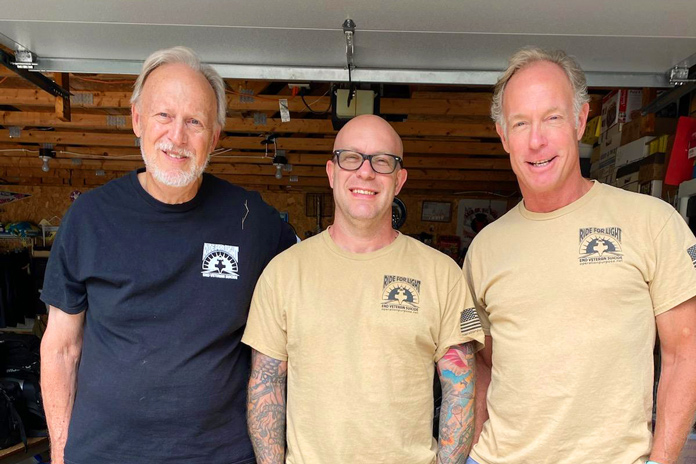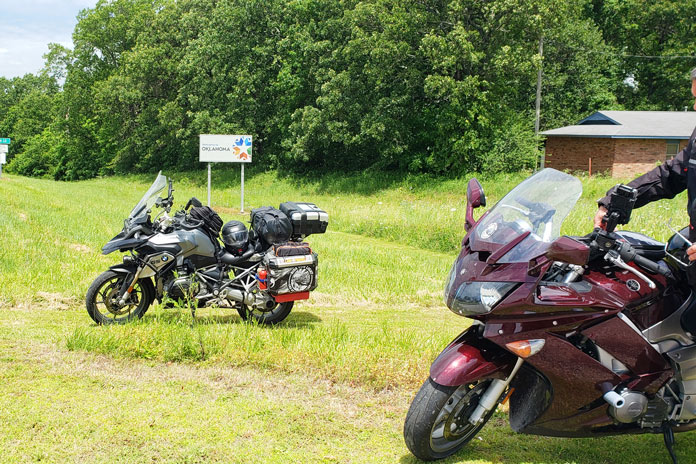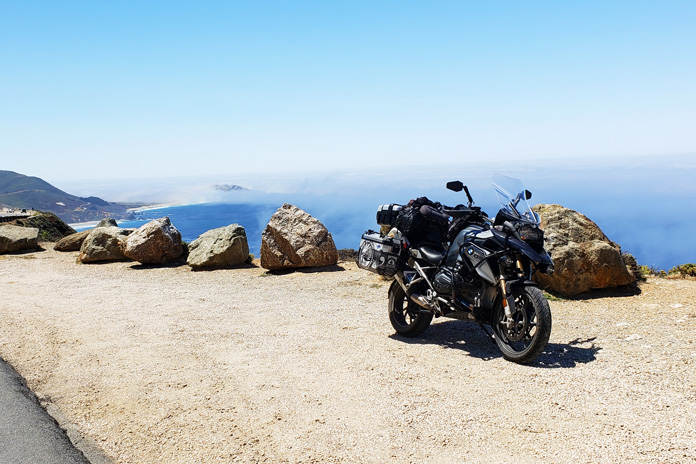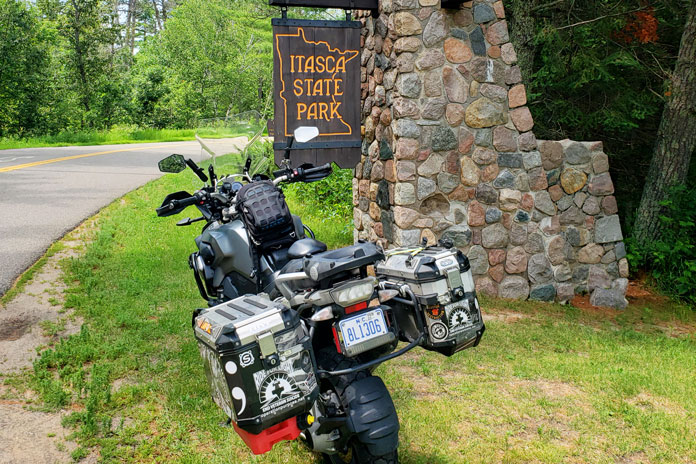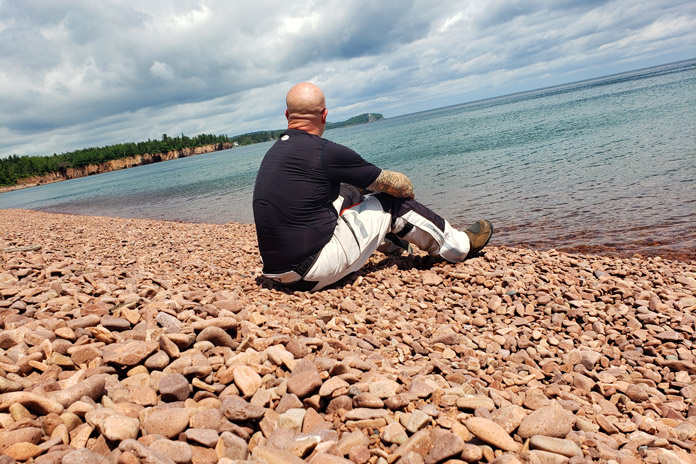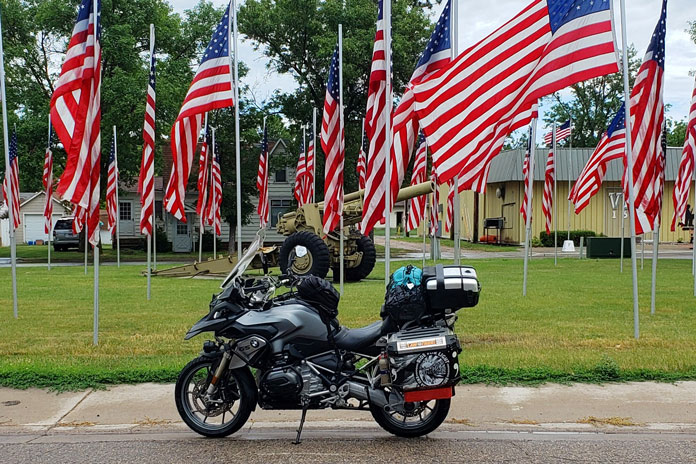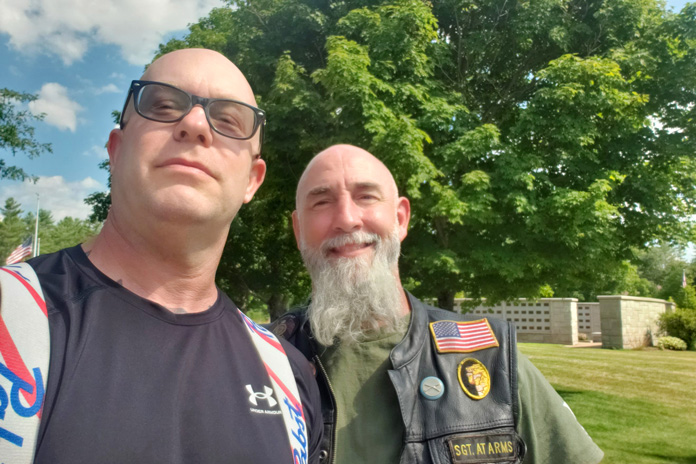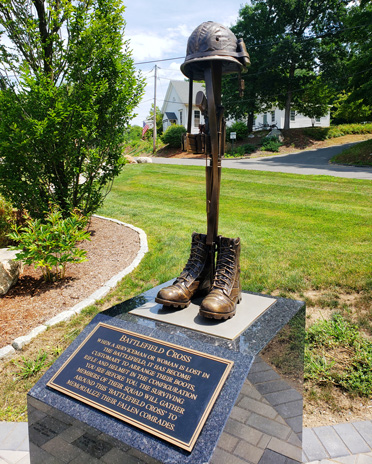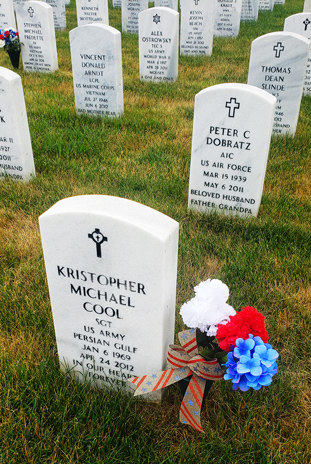
In his intro video on the Ride for Light Facebook page, former Army paratrooper Perry Steed says there has been something he has been unable to do for the last 10 years – an obstacle he hasn’t overcome.
“That obstacle has been going to collect one of my very best friend’s ashes,” he says with solemnity in his voice.
On April 24, 2012, Sgt. Kristopher Cool took his own life. Steed says he has known several people who died by suicide both before and since Cool, but his friend’s death has been “the worst one for so many reasons.”
I can relate to Steed’s struggles. I’ve never been any good with death, whether it was from old age, a tragic accident, or suicide. But it’s a little harder in the case of suicide because of the conflicting feelings for those left behind. In 2014, a good friend of mine who was a veteran took his own life, and I still get choked up thinking about the pain he must’ve been feeling and the times we haven’t been able to share since.
According to the website for Steed’s nonprofit, Operation: Purpose, veterans are 50% more likely to die from suicide than those who haven’t served, and what started as a mission to retrieve his friend’s ashes in Minnesota and take them to Fort Bragg to spread on Sicily Drop Zone became a “rally cry for support.” On May 20, Steed departed Wilmington, North Carolina, on a 2013 BMW R 1200 GS for a 48-state trip covering more than 15,000 miles. He returned home August 14.
Related Story: 2014 BMW R 1200 GS Adventure Review
“This ride is meant to provide Kristopher a final resting place,” the Operation: Purpose website states, “while also illuminating the issue of veterans’ mental health.”
When I first contacted Steed in June, he had made it to my neck of the woods in the southeastern corner of Utah.
“None of us can save the 22 that died yesterday,” he told me, referring to the Veterans Affairs statistic that 22 veterans take their own lives each day. “But if we can save one today, maybe they can help save two tomorrow. And then we can get this thing under control.”
More Than a Promise
Steed served as a forward observer in the Bravo 1st Battalion, 319th Field Artillery Regiment, 82nd Airborne Division from 1994 to 1997. He met Cool at the 82nd replacement. Steed was coming from jump school, and Cool was working the change of quarters desk. “We got to chitchatting about music, and we had similar tastes.”
The two men served together in the 82nd Airborne Division. Cool left the service a year before Steed, but the two stayed in contact over the years, including a stint when they lived in the same town.
“For a long time, he and I were pretty much inseparable.” Steed paused, and his next words were heavier. “Those were good times.”
In April 2012, Steed got a call he said he was expecting. “But I couldn’t hear it. My friend had died by suicide.”
The news hit him hard, and he formulated the plan to gather the ashes.
“But every time it came around for me to do it, I just couldn’t seem to make it happen.”
Steed said he struggled with his own instabilities for several years, and when he heard the news about Cool, he was trying to focus on his family.
“In fact, when I got the call, I was waiting for my wife to come home so we could go to childbirth class for our middle child,” he said. “So I focused on trying to be there for them. But I haven’t been there for myself.”
But the tragedies kept “building and building,” he said, including the deaths of more than two dozen family members and friends from various causes.
“They’re not all old people that had lived a full life. A lot of these people were cut down in their prime, and there have been a few suicides.”
He tried to keep motoring on, but everything came crashing down when his father-in-law died of cancer in 2019.
“He was the glue keeping me together,” Steed said, “because I had been focusing on getting him to his treatments, to his doctor’s appointments – just being there and doing things.”
Earlier in our interview, Steed said he had left from Fruita, Colorado, that morning, taking U.S. Route 191 and visiting Arches National Park, one of five national parks in Utah, and was talking to me from one of his father-in-law’s favorite spots in Mexican Hat, Utah, on U.S. Route 163.
“I’m actually sitting in the motel that he talked about for years and years, and wanting to come back,” he said. “I’m here to spread some of his ashes tonight. I carry him with me everywhere. I was raised by a good family, but when I met this man and asked if I could marry his daughter, he turned into my dad.”
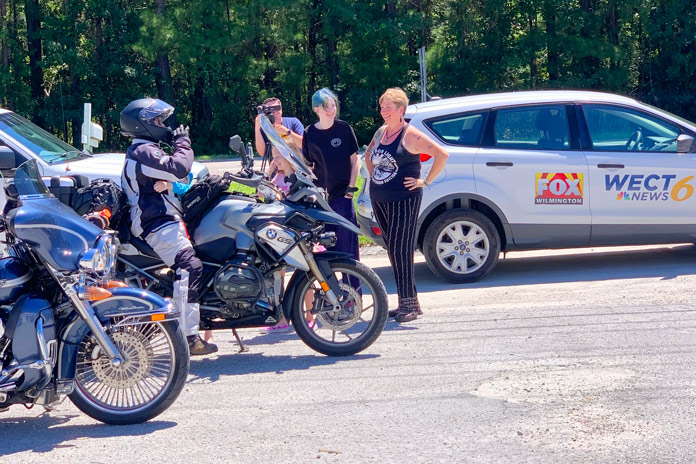
Once his father-in-law died, “everything spiraled out of control for my family and me. And then Covid hit.”
He said the pandemic felt like a reset for a lot of people, himself included. He started using VA grief counseling tools and “put in a whole lot of work to get myself to where I could honor the promise I made when Kris passed away to go get his ashes.”
Before Christmas 2021, Steed spoke with his wife, who encouraged him to do it. The idea of the trip got him thinking about a friend in Oklahoma he had served with and who had been difficult to reach for quite a while.
“People don’t pop into my head for no reason,” he said. “So if someone pops into my head, there’s a higher calling for me to reach out to that person. I’m going to find them and I’m going to call them and I’m going to check on them.”
At that point, the purpose of the trip evolved.
“It’s me checking on battle buddies, guys I served with, friends of guys I served with, complete strangers.”
Over the course of reaching out to people, Steed reestablished a connection with a friend he served with who lives in San Luis Obispo, California.
“I told him, ‘Hey man, I’m getting ready to do this crazy thing. Hell, I might even come to California.’”
When Steed explained the impetus for his trip, the friend asked if Steed would also retrieve the ashes of his brother, Specialist David J. Howard.
“I haven’t physically seen this guy in California in over 20 years, and he still thinks enough of me to trust me with some of his brother’s remains knowing that I’m going to do exactly what I told him I would do and spread those ashes on Fort Bragg.”
The Pros and Cons of 15,000 Miles of Helmet Time
Steed has been riding motorcycles for about 13 years. While the 1200 GS is his chosen mount for this mission – a bike he said was a holdout for him, even with the rave reviews – it’s not the only bike in his stable. His first motorcycle was an ’84 BMW R 80 RT.
“I spent a ton of money getting that thing right,” he said. “I still have it.”
He also owns an ’81 Yamaha XS 650, an ’84 BMW R 100 RT, a ’74 Moto Guzzi Eldorado, and a 2015 Suzuki V-Strom 650XT. A full stable indeed.
After more than a decade in the saddle, he’s no stranger to helmet time, but the Ride for Light provided more of a challenge. For one, it was longer than any rides he had previously taken.
“I did a mini trip last summer,” he said. “I rode 2,500 miles, just around North Carolina and Virginia and those areas, to see if I could even handle being in my head that long.”
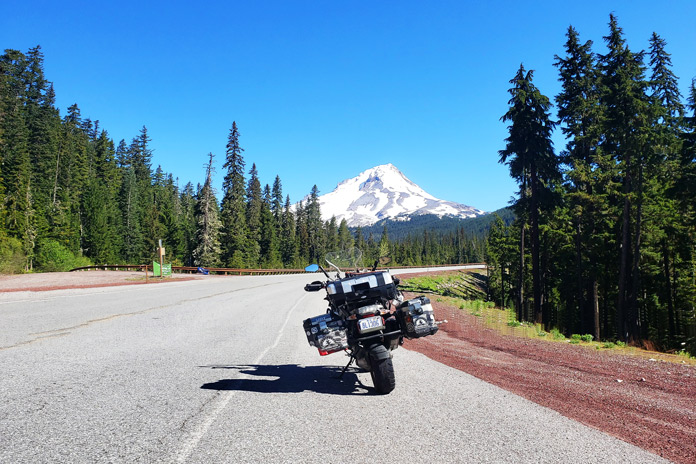
Steed originally planned on doing the trip solo, but he was joined along the way by various friends and family. When he set out from North Carolina, he had a friend who is also a veteran ride along with him for the first five days and then split off in Georgia, at which point Steed was joined by a cousin who rode with him about 1,100 miles to the Oklahoma state line.
“He’s been riding for a long time,” Steed said of the cousin, “but as far as long stretches in the saddle, that’s the longest he’s ever done.”
In addition to the distance, his cousin had also never ridden with anyone else, which provided Steed some opportunities for coaching and helped break up the monotony. But more than that, Steed was glad for the cousin to come along because he is a veteran as well.
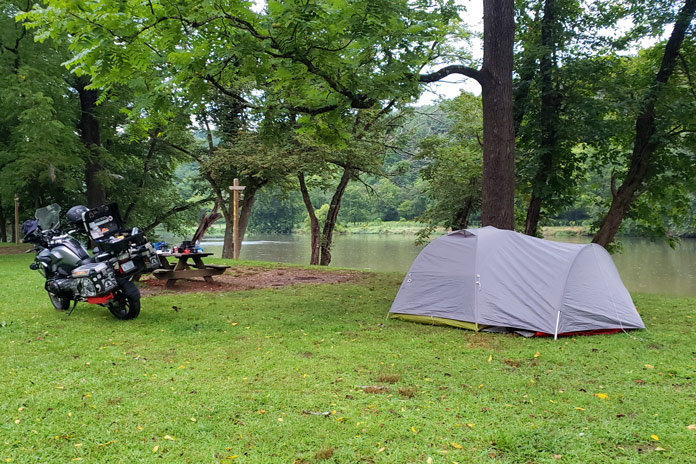
“He downplays his military service, but he still signed a blank check. He’s a good dude.”
And Steed ultimately connected with that friend in Tulsa, Oklahoma. They rode together to Fort Sill, where Steed had completed basic and advanced individual training. The two rode about 700 miles together.
Besides the camaraderie, the other advantage to having someone else along is in case of a mishap. After riding the Tail of the Dragon in Tennessee with the friend who had been with him from the start, Steed separated a rib doing some off-roading on a forestry road. At that point in the trip, he had become used to having someone tag along. He felt like he could push himself, take a few more chances, and do a little more off-roading. When his friend split off, that changed.

“All that stuff was gone,” he said. “I had to come to grips with no guarantees of anybody doing it with me.”
When you get used to someone being around – even if just for a short time – it makes it harder when they’re gone, like when a good friend comes to visit and you feel a little bit lonely when they leave.
Or when a friend you’ve known for many years takes his own life.
In the late 1970s, psychiatrist Dr. Bessel Van Der Kolk started working with Vietnam veterans. Interestingly, his first patient would ride his Harley to bring himself down from moments of rage brought on by his trauma.
“The vibrations, speed, and danger of that ride helped him pull himself back together,” Van Der Kolk wrote in his 2014 book The Body Keeps the Score.
Van Der Kolk’s original work took place before post-traumatic stress disorder was an official diagnosis. These days, his contributions are considered pivotal in the field of trauma. He says one area of difficulty shared by those dealing with trauma is the inability to live in the moment. This capacity is the foundation of meditation and the somewhat recently coined term of “mindfulness.”
Personally, I appreciate the fact that when I’m on my bike, I’m only on my bike. Preoccupied with operating the machine, there isn’t much room to think about a troubling situation at work or home. The past and the future don’t matter nearly as much as the present moment.
For Steed, that wasn’t always the case on this trip.
“I’m stuck in my head and in my helmet all day,” he told me in June. “It’s like when you’ve got two kids who don’t get along, you lock them in a room together and say, ‘You guys are going to be getting along before you walk out of this room.’ That’s me, man. Some days my biggest fights are with myself.”
But this was a battle he was determined to win.
“Just today, I got in my head this morning,” he said. “I didn’t want to ride. I didn’t want to go anywhere. I was fumbling around getting ready, and I was awake almost all night for no reason.”
Steed said that as men, we try to find out the rationale, to get to the “why” for everything.
“But it’s just me,” he said. “It’s how I am. It’s how I’m wired. A success for me is going to be if I can get out of this trip being able to live in my head better.”
Steed said he could’ve chosen to fly to all these places to retrieve the ashes, maybe checked in on friends that way, “but I have things I also need to work out.”
“I need to be a better person for myself. I need to be a better husband for my wife, a better father for my children. I need to be a better friend, a better brother, a better son. With all these demons lurking over me, I’m out here trying to just pay all the kindness forward that I can, check on these folks, talk some stuff out with people I haven’t seen in a long time, and try to have some fun of my own.”
And there have been good times.
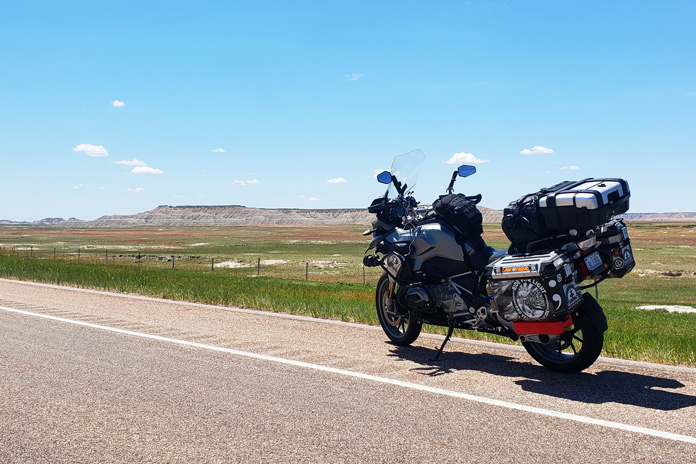
When you hit 48 states on a bike, you can’t list all the spots, but there are some eye-poppers worthy of mention. Although Utah is definitely beautiful, it was hot when he came through my home state, with temps in the triple digits. People in the Southwest like to say, “but it’s a dry heat,” to which Steed replied, “The only difference between a wet heat and dry heat is that with a dry heat, you don’t know you’re dying. Even though this GS is a waterhead, it was still not liking it.”
I can’t imagine Amarillo, Texas, was much cooler, but he has some great pics and videos of his stop at the Cadillac Ranch on his Facebook page. He rode in some “hellacious storms” along the way, and he stuck his feet in the Gulf of Mexico – “with my riding boots on.” There was a spark in his voice when he spoke of riding the Tail of the Dragon. After a couple days’ rest following his off-road crash and waiting out the rain, he rode it again.
Then there are the people, of course. Beyond visiting friends and family, he’s met a slew of strangers.
After a mishap with his bike in Oklahoma, Steed stayed an extra day and got to meet some friends of his buddy who were also veterans, some of whom had pulled “some pretty serious duty.”
He also mentioned a 20-year military veteran who was particularly inspiring. Steed said the man, who had been hospitalized twice for mental issues, had been rudderless until he started volunteering in a VA nursing home after retiring from the service.
After seeing the lack of attention paid to a couple of soldiers who had died under VA care, the man went to school to become a mortician and a funeral director, Steed said, with the mission of giving veterans the best burial they deserve.
“That is a fantastic thing to do for someone,” he said. “That really touched me. Because it’s not just Iraq and Afghanistan veterans I’m trying to help. A huge segment of our population that never received any kind of help were Vietnam vets.”
He said that, 50 years later, Vietnam veterans are still trying to figure out their place in this world.
“They were spit on or ridiculed when they got home. A lot of the veterans that end up committing suicide are from that theater of conflict and age demographic. Veterans often feel like they can’t help anybody and all they’re doing is hurting other people, so that’s why they do it.”
Steed said the people he’s met kept him going.
“Every positive reaction I get from telling people about what I’m doing makes me want to talk to somebody else,” he said. “This has been an exercise in me stretching my capabilities as far as reaching out to folks.”
Then there were the people waiting back home, namely his wife and three kids.
“If it wasn’t for my wife and children, there’s no way I could do this,” he said. “My wife has been the biggest cheerleader I’ve had.”
He said when he was having a difficult day, one that started with depression or anxiety, his wife was his support.
“It puts a lot of pressure on her, and I feel terrible about it sometimes, but if I’m having a rough day, I have to call her. She’s the one who has kept my head right for so long.”
Finally, he said he believes he’s getting help from those he’s lost over the last 10 years.
“Somebody’s watching out for me,” he said. “Of all the people I’ve buried that meant so much to me, I think they’re all having a huddle upstairs and saying, ‘Dude, we gotta get this guy straight.’”
The Road Keeps Rolling
In the 1994 movie Shawshank Redemption, two of the main characters reference a choice: Get busy living or get busy dying.
Steed’s mission will be over at some point. As of this writing, he has ridden 48 states and rolled back home to his family, and plans are in the works to spread the ashes of Cool and Howard at the Sicily Drop Point. But he’s determined not to make that the end of the road. This wasn’t just a trip about death; it’s about life.
Steed said that while he has been helped by the VA in many ways, he also recognizes its deficits. He has been researching various organizations that help veterans and is working on his 501(c)(3) status for Operation: Purpose, as well as accepting donations on his website.
“The real disconnect is placement for veterans in crisis and their families,” he said. “Who do you call? What do you do? Everyone knows the suicide hotline, but what happens after that? The goal is to create an education program for families and veterans.”
Steed knows some therapists willing to donate their time, and he is working with someone to apply for grants for Mental Health First Aid training, which helps someone who encounters another in a mental health crisis.
“You have skills available to talk them down, calm them down, and get them somewhere where they can think more rationally, or you can get them help without them harming themselves.”
Steed wants veterans to feel like they have another option besides ending their lives.
His long-term goal is to ultimately create a multiuse space similar to those seen on military installations, but in the immediate future, his first step is to create a database of key people in his area. He compared it to the military term “interlocking fields of fire.”
“I’ve got guys who are spread out in the greater Wilmington area, and it’s a network of people who know the veterans,” he said, adding that there are a lot of retired or ex-military in Wilmington, as well as several military bases in North Carolina in general. “We know a lot of people. We can be there for each other. We can be the ear and the shoulder and can offer redirection if that’s feasible.”
This support is what Operation: Purpose is all about.
“We may wake up tomorrow morning and the VA won’t be there anymore, but we still need to help each other. We didn’t have the VA when we were in [the service], but we had each other, and I need to reestablish that line of thinking, to bring the camaraderie and the unity and help each other get our dignity back and a hope for a better day.”
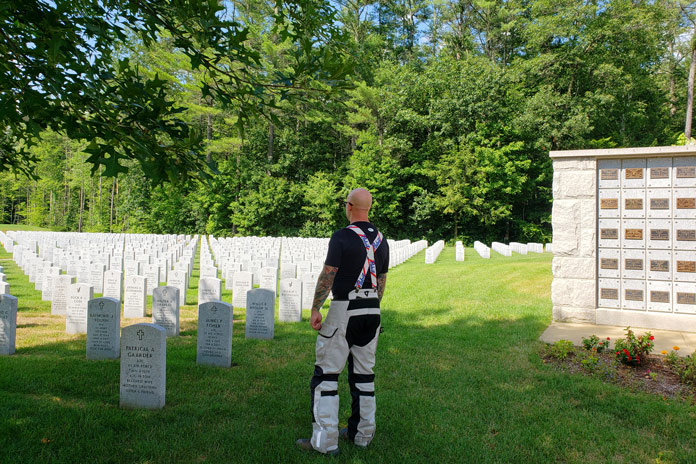
For more information, to make a donation, or to buy Operation: Purpose merchandise that supports veterans in crisis, visit OperationPurpose.net.
This article first appeared in the October issue of Rider. All photos courtesy of Perry Steed. Paul Dail joined the Rider staff as Associate Editor in June. This is his first story for the magazine. He also wrote the Exhaust Note for the October issue.
The post Veteran Takes a 15,000-mile ‘Ride for Light’ first appeared on Rider Magazine.
Source: RiderMagazine.com

